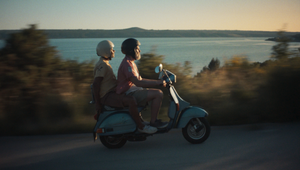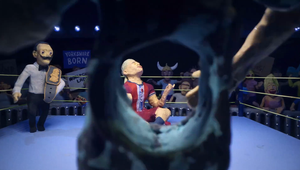
You’ll Never See These 4 Classic Films the Same Way Again

It all started when I first saw David Bowie transform from a barn owl into a goblin king and
again when I saw it happen in the film Labyrinth. It was about the same time I
also became fascinated by cod pieces.
What started,
you ask? Thankfully not a new fashion trend but a deep love of film...
Having been lucky
enough to work my way into a telecine department, I’ve been able to indulge my favourite
hobby in the colour suite for the past eight years (film, not cod pieces)
When it comes
to grading you often use a colour reference and I hazard most people in this
industry are mega film, photography and/or art buffs in some way. However, for
a colourist this creative input can be a blessing and a curse when it comes to
the suite. It can be a mine-field to amalgamate people’s ideas for their
project and a reference that works with the location, lighting and set design
of their existing film. Working with Directors, DoPs or creatives that have had
a strong visual idea to start with makes a colourist's job much easier too.
Films of real
beauty - from a colour perspective - tend to take colour into consideration in
the pre-production stages and have a considered aesthetic throughout. Whilst
there are so many wondrous examples I’d love to talk about, there are four films
by British directors that are excellent examples of good use of colour.
Every single one of the films below has served as a bold reference point for jobs that I’ve graded. If you take a careful look at the colour design in these films, you’ll never be able to watch them in the same way again…
The Cook, The
Thief, His Wife and Her Lover - My
all-time favourite
This is, in my opinion, the best use of colour in any film ever. Set
pretty much entirely in the amazing restaurant ‘Le Hollandais’, the film uses
colour to draw parallels between different rooms in the building and the human
body. For example, in the back passage there are the browns of the rotten food
left there. The kitchen is the stomach and is lit in green. The dining room is
the strong reds of the mouth and the bathroom is a pure white. The bathroom is
Helen Mirren’s sanctuary, the soft pink light symbolising her gender. Mirren’s
dress famously changes colour like a chameleon as she walks through the
different settings.
It’s an amazing use of production design and lighting and I’ve
used it many times as a reference to help give scenes shape and purpose. Plus,
any film that ends with Michael Gambon eating a roasted penis has got to be
good. I got to use the idea of using colour to separate rooms within a specific
space when I worked with Dawn Shadforth on her video for Metronomy’s ‘Old
Skool’.
Metronomy - Old Skool
Black
Narcissus – Sex, Nuns and Deborah Kerr
Going Full Mental
The Archer’s 1947 film is rightly considered a masterpiece of
colour. Jack Cardiff and Alfred Junge both won Oscars for their work –
Cinematography and Art Direction respectively. Filmed in Technicolor, the film
is dripping with colour. And sex. And Nuns. It’s a heady mix.
Sometime after releasing his film, Powell described how he painted
the mountains in the film on glass: “We decided to do the whole thing in the
studio and that's the way we managed to maintain colour control to the very
end. Sometimes in a film its theme or its colour are more important than the
plot.”
The different characters in the film had a big pull on Powell and
Pressburger’s colour design. The nuns are always cast in white light, whilst
the Indians are decked in the rich warm colours of the jewels they wear. Any new character introduced tends to be
purposely muted and dark. The colour design also works as a device in this film
to reflect the nun’s mental and erotic state.
Throughout the film, the juxtaposition of the lush vegetation of
the Himalayas with the austerity of the convent is yet another layer that
reflects just how much consideration went into the use of colour by the
filmmakers of this classic - and watching Deborah Kerr go full mental is always
entertaining.


Vertigo – How to drop ‘Tetradic’ casually in to
conversation
Voted the best film ever in Sight and Sound in 2012, there is a lot of academic writing on Hitchcock’s use of colour in this bad boy. The systematic use of reds versus greens is a real favourite. The scene in which James Stewart first sees Kim Novak is in a vivid red restaurant. Her green dress is symbolic of the colour of jealousy and death whilst also a stark contrast to her background which draws us to her mysterious presence.

Any scene with Kovak in it will use green somewhere. Stewart is
generally surrounded by red – like the restaurant is, the first time she enters
his life. The colours switch when they return to Jimmy’s home - just to mix it
up on some probably highly clever and intellectual level. Anything a colourist
can do to help create depth in a two-dimensional medium is always good and it
is often why complementary colours are used in productions so frequently.
Hitchcock decides to show off. He has sub plots that involve a yellow and blue
colour motif, meaning that this film has what is called a tetradic colour
scheme. (I challenge you to try and drop that term casually into a
conversation. I’ve tried and failed and I’m a colourist.)
I recently used elements of this in a video for Tom Odell. We used cooler colours to signify objects and places that are unattainable for Kevin Spacey and to foreshadow the ending.


Don’t Look
Now – Deeper shades of red
This gothic horror has two glaring motifs – water and the colour red. So we have something that is normally blue in the background as well as varying shades of red that transfigure from the red of grief to the red of warning and ending with the red of menace and anger. The blue-red motif also creates separation in the frame giving us a good feel of distance, which is something that colourists are always banging on about.


There’s a lot to take in when you’re watching this film, from the creepiness of the blind psychic, to the cheeky sex scene and Donald Sutherland’s awesome moustache. It’s got something for everyone.

Roeg also shot the classic film ‘The Masque of the Red Death’ for Roger Corman which unsurprisingly is celebrated for it’s use of colour – primarily red as the title suggested but towards the end the colour goes as crazy as Vincent Price does. Price also has a number of mean looking cod pieces in this too, so once again another reason to watch it.


Images courtesy of https://film-grab.com/















